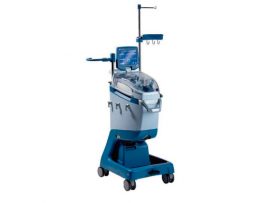Abstract Lightning strike injuries have a high mortality rate and frequently result in immediate cardiac arrest. Although extracorporeal cardiopulmonary resuscitation (ECPR) is increasingly used for out-of-hospital cardiac arrest, its role..
Read MoreAbstract Objectives Maintaining a nadir oxygen delivery ≥ 280 mL/min/m2 during cardiopulmonary bypass is a pillar of the goal-directed perfusion strategy in cardiac surgery. However, there are patients who develop a..
Read MoreAbstract Objectives Minimal invasive Extracorporeal Circulation (MiECC) and Hybrid System (HS) have been introduced to potentially reduce the inflammatory response compared to conventional Cardiopulmonary Bypass (cCPB). The HS combines elements..
Read MoreAbstract As survival among patients with congenital heart disease (CHD) continues to improve, the population of adults with CHD (ACHD) is rapidly growing. These patients often present with complex anatomy,..
Read MoreAbstract Background Although extracorporeal cardiopulmonary resuscitation (ECPR) has shown promise for refractory out-of-hospital cardiac arrest (CA), limited data exist regarding its application in cases involving severe primary blast lung injury..
Read MoreAbstract Objective Postoperative cardiac dysfunction and arrhythmias are significant complications following cardiac surgery, frequently resulting in increased mortality, longer hospital stays, higher healthcare costs, and diminished patient quality of life...
Read MoreAbstract Introduction Cardiopulmonary bypass (CPB) plays a central role in pediatric cardiac surgery, yet standardized quality indicators (QIs) specific to pediatric practice remain underutilized across institutions. Methods A comprehensive review..
Read MoreAbstract To evaluate a novel anticoagulation strategy in an extracorporeal circuit, we introduce a device that induces local hypothermia as blood flows through the circuit. Using a pig model, we..
Read MoreAbstract Background/Objectives: Mechanical circulatory support (MCS) is increasingly utilized for the management of acute decompensated heart failure (HF) and cardiogenic shock (CS). The primary goals of MCS are to restore systemic..
Read MoreAbstract Thrombosis and inflammation represent major challenges limiting the functionality of asymmetric poly(4-methyl-1-pentene) (PMP) hollow fiber membranes in extracorporeal membrane oxygenation (ECMO) systems. Moreover, the interplay between these two pathological..
Read MoreAbstract How are clinicians to preserve core clinical skills in an era of algorithmic assistance? As artificial intelligence (AI) assumes a growing role in clinical practice, concern is mounting that..
Read MoreAbstract Introduction Current extracorporeal membrane oxygenation (ECMO) monitoring methods for circuit obstructions have limitations. In this study, we test the hypothesis that changes in flow in a pre-existing shunt tubing..
Read MoreAbstract Background Neurological complications significantly contributed to mortality in patients with acute respiratory distress syndrome (ARDS) supported by venovenous extracorporeal membrane oxygenation (VV ECMO). Early fluctuations in arterial partial pressure..
Read MoreAbstract Vilobelimab, a first-in-class, human–mouse chimeric immunoglobulin G4 (IgG4) kappa monoclonal antibody, targets human complement component 5a (C5a) in plasma. Unlike upstream complement inhibitors, vilobelimab does not inhibit the generation..
Read MoreAbstract Background The COVID-19 Pandemic challenged the healthcare system worldwide, but its effect on outcomes of cardiac arrest (CA) and extracorporeal membrane oxygenation (ECMO) use are understudied. We examined trends..
Read MoreAbstract Purpose Postoperative bleeding is a major concern in pediatric cardiac surgery under cardiopulmonary bypass (CPB). The comparative utility of viscoelastic testing and central laboratory assays for predicting bleeding risk..
Read MoreAbstract Introduction Patients who undergo cardiac surgery have a high risk of significant blood loss and anemia. While allogeneic red blood cell (RBC) transfusions are effective, they are associated with..
Read MoreAbstract Perioperative hemorrhage during cardiac surgery is a frequent occurrence and can result in significant morbidity and mortality for patients. Prothrombin complex concentrate (PCC) and recombinant factor VIIa (rFVIIa) are..
Read MoreAbstract BACKGROUND: Patients on venoarterial extracorporeal membrane oxygenation (VA-ECMO) are frequently managed with varying degrees of hyperoxia. Existing data suggest that higher levels of Pao2 correlate with worsened outcome in patients..
Read MoreAbstract We appreciate the insightful remarks by Sin et al regarding our systematic review and meta-analysis on extracorporeal membrane oxygenation (ECMO) cannulation by intensivists. Their comments highlight important considerations for..
Read MoreAbstract Introduction Postoperative delirium (POD) is a frequent and serious complication after cardiac surgery. The glucose-to-albumin ratio (GAR) integrates metabolic and nutritional status, but its predictive value for POD in..
Read MoreAbstract Managing severe (AS) alongside complex (CAD) in frail patients is challenging. A 79-year-old female with resting dyspnea was diagnosed with severe AS and CAD. While (CABG) was the appropriate treatment for CAD,..
Read MoreAbstract Negative pressure ventilation (NPV) has been used to assist patients with respiratory failure. Venovenous extracorporeal membrane oxygenation (V-V ECMO) supports patients with acute lung injury who do not respond..
Read MoreAbstract Background Tranexamic acid (TXA) is recommended for reducing blood loss and transfusion in cardiac surgery. However, there are concerns regarding the safety profile of TXA, especially its proconvulsant effects...
Read MoreAbstract Introduction Bleeding events are common during the provision of Venoarterial ECMO (VA ECMO). Previous observational has suggested that these bleeding events are associated with an increased risk of in-hospital..
Read MoreAbstract BACKGROUND The use of extracorporeal life support (ECLS) in the trauma population remains controversial and has been reported only in small cohort studies. Recent ECLS technical advances have increased..
Read MoreAbstract Background The role of cardiac surgery in octogenarians is debated, but limited data exist for patients aged 65–79. This study compared clinical characteristics, surgical procedures, and outcomes between patients ≥ 80..
Read MoreAbstract Objective Metabolic acidosis is a common complication following cardiac surgery with cardiopulmonary bypass (CPB). Recent evidence suggests that unmeasured anions (UAs), assessed via the strong ion gap (SIG), may..
Read MoreAbstract Objectives To evaluate ECMO-related morbidity and mortality between Early-term (ET) and Full-term (FT) infants. Methods We performed a retrospective review of 3,831 neonatal ECMO runs for meconium aspiration syndrome..
Read MoreAbstract Objective To investigate the impact of veno-venous extracorporeal membrane oxygenation (VV-ECMO) cannula configuration and ECMO blood flow on intravascular hemodynamic environment, oxygen saturation, hemolysis, and thrombotic risk under varying..
Read More



















